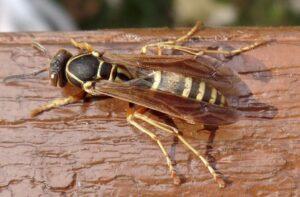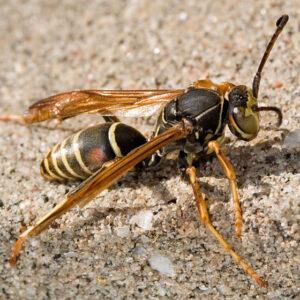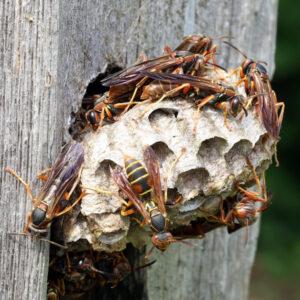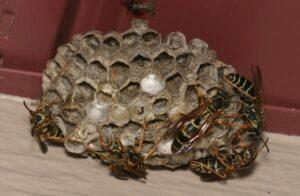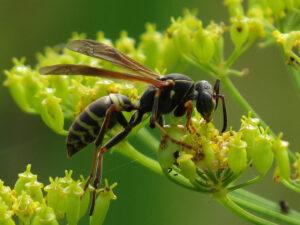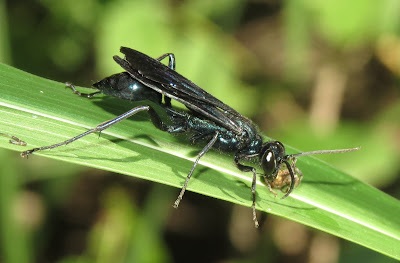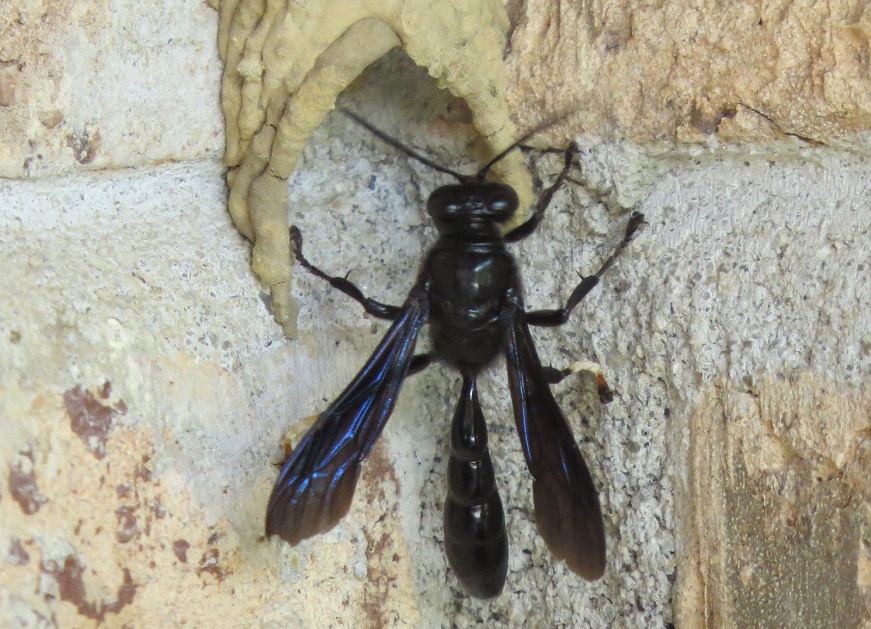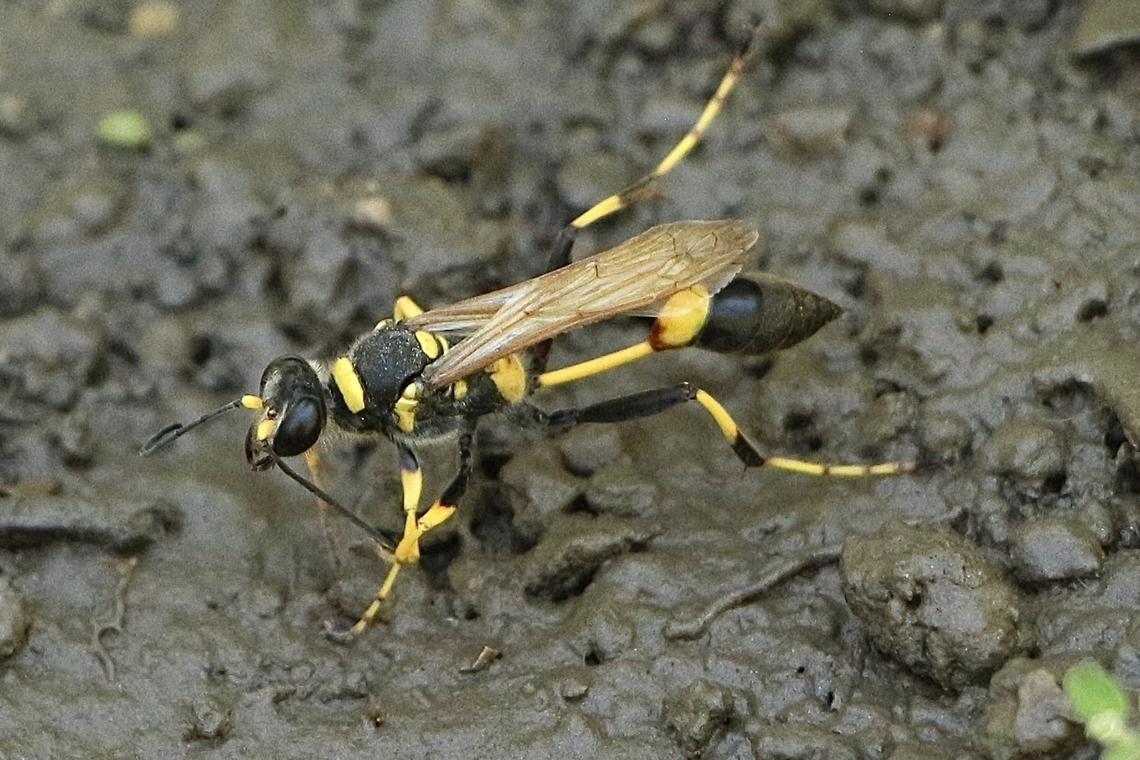Northern Paper Wasp (Polistes fuscatus)
Updated on
28/10/2022The Northern paper wasp is a social species that ranges from Southern Canada to Central North America, especially in the temperate zone. They like to build nests around human civilization. Other common names are – golden paper wasp, dark paper wasp, and common paper wasp.
Scientific Classification
- Class:Insecta
- Order:Hymenoptera
- Family:Vespidae
- Subfamily:Polistinae
- Tribe:Polistini
- Genus:Polistes
- Species:P. fuscatus
Conservation Status
Description and Identification
A northern paper wasp’s length ranges from about 0.59-0.83 inches (15-21mm).
Their body color is geographically variable, with three different morphs in the United States alone.
Wasps from Virginia display bright red and yellow concentric abdominal spots. In contrast, the ones in Illinois have abdomens striped with red dots.
The variation of the species from Florida has a red spotted abdomen on a solid black-colored body.
In Quebec, the species displays two different color patterns-
One with yellow abdominal spots and stripes and no red markings, and the other with yellow abdominal stripes, lacking both spots and red markings.
Their head and thorax are covered with short hair. They have slender-shaped bodies with a waist that connects the thorax to their abdomen. The female’s abdomen has six segments, while the male has seven abdominal segments.
The forewing length in females is shorter (0.43 in) than in males (0.51 in). Their wings are transparent and smoky. They are folded over the body when the wasp is at rest.
There are three small, simple eyes called ocelli between the two big compound eyes on top of their head. Their face plate is pointed at the end. It is yellow or reddish-brown and has no black marks.
They have long, brownish-black colored antennae which are curled at the tip in males.
Females possess a highly venomous sting which is absent in males.
The northern paper wasp has long yellow-colored legs. The fourth segment (tibia) has two spurs at the end of the middle leg. There is a presence of simple claws at the end of their foot (tarsus).
Distribution: Northern range- British Columbia, Quebec, Chilcotin. Southernmost range- Texas, Florida. Also found in Jamaica, Bermuda, and Barbados.
Habitat: Woodlands, savannas. They also nest nearby human civilizations where wooden structures are present.
Do They Bite/Sting: The female wasp’s sting is excruciatingly painful.
Lifespan: 1 year in the wild
Predators: Birds, rodents, and foxes.
Behavior and Characteristics
Rank and hierarchy
As a social insect, the northern paper wasp has communication avenues for nesting, defense, and hierarchy building.
The fertility of each wasp in a colony forms the basis for a rank system, where every higher ranked wasp displays dominance over the wasps just below them in the hierarchy. This is a unique hierarchical system followed by northern paper wasps.
Dominant females in the colony have larger and more developed ovaries.
Hierarchy is first formed between females fighting for the position of foundress and later between worker wasps. The second highest ranked female becomes the primary egg layer when the foundress is removed or dies.
The foundress and other egg-laying wasps of the colony also display their dominance over other female wasps by occasionally eating other female wasps’ eggs approximately eleven minutes post being laid. However, they recognize their own eggs and would never accidentally ingest them.
Oviposition and oophagy(egg eating by embryos inside the mother’s uterus) occur close together in females. Given the dominant egg layers’ greater supply of ova from the subordinate egg layers, subordinate egg layers cannot lay eggs as quickly as dominant egg layers.
Subordinate egg layers no longer lay eggs after being around the higher-ranking females after a certain period. Expending energy during foraging and not investing as much into their eggs might be why they go through this phase.
The difference between a foundress and her subordinates is distinguishable by their body posture, with the former sitting higher and displaying threatening postures to maintain superiority.
It is not uncommon between subordinates or individuals with equal rank to engage in ‘falling fights’ to rise in the hierarchical order. The wasps, higher in the hierarchy, dart and attack lower ranked wasps to maintain their status and power.
Ability to recognize and identify their nests
Members of a colony can differentiate between other residents and non-residents depending upon how a wasp approaches a nest. Resident wasps usually dart or fly straight into the nest, whereas non-residents linger around and hover outside the nest.
There are seldom accidents of mistaken identity among members of the same colony. When a resident wasp recently returns from foraging, it is stuffed and heavy and cannot obtain the necessary speed to enter the nest. The wasp gets accidentally identified as a non-resident.
To prevent this, the wasp will make several speed trials to enter the nest until it achieves the necessary speed.
Non-members of a colony are ousted within a few minutes when they are recognized.
Ability to recognize their nest mates
The ability to recognize individuals among members of the northern paper wasps helps dictate how one wasp treats another. This skill of northern paper wasps helps determine if a wasp needs to hold a dominant role or has to act submissively within an interaction.
The species can recognize individual members through specific facial and abdominal markings. Wasps also use chemical cues to identify nest-mates and foreign wasps.
Some studies have helped confirm this unique identification talent in wasps. According to researchers, the wasps whose markings and stripes were tampered with and altered had to deal with aggression when reintroduced back into the colony.
This helped erase any doubts that physical characteristics in an individual had something to do with the hierarchical position of a wasp in the colony. Moreover, the tests helped to ascertain the point that markings helped wasps identify each member of the colony individually.
Individual recognition also helps foundress females reduce aggressiveness among other dominant members of the colony and keep them under control. This recognition also helps the foundress track resources allotted to each member of the colony.
Northern paper wasps lose this ability when they live in isolation for too long.
Defending and protecting the colony
The primary queen and her oldest workers are responsible for the colony’s defense. The queen is pretty non-tolerant against intruders in the settlement and will attack aggressively and instantly.
Humans and animals disturbing a nest may get stung several times by a single wasp because, unlike bees, these wasps do not die after one sting. Their stinger is easily removable from the skin without remaining embedded.
The queen wasp puts a lot of effort into building a nest but neglects that all the food and resources are allocated to one common area. This attracts vertebrate predators who destroy the nest, making it impossible to rebuild. The wasp colonies usually avoid fighting back when attacked by much larger predators and prefer fleeing away.
Diet and Foraging
The northern paper wasp habitually returns to a specific location or to prey on the same species. The ability to communicate to nestmates about the establishment of a resource stronghold is an asset to their colony development.
Northern paper wasps collect food from different sources.
They get carbohydrates from nectar and pollen. They collect wood-sap and plant fibers from wood. They scavenge or accumulate animal proteins from bees, ants, termites, caterpillars, flies, etc.
They collect water from natural and artificial sources and mix it with plant fibers to make a pulp. This pulp is used up to build the nests.
Carbohydrates and proteins are used as food and energy. In contrast, water is used for metabolism and regulating body temperature.
Life Cycle
Spring and summer set the onset of mating season in the northern paper wasps.
After abandoning their nests, the females release venom that contains a sex pheromone that induces copulation tendencies in males.
Males will sit out waiting to pursue females to mate. Once a female is spotted, the sexually responsive male tries to mount the female and begins performing abdominal stroking.
During sexual intercourse, the male wasp displays various other body movements. Some include clasping and holding on to the female abdomen, causing movements in its body by vibrating its antennas in a rhythm and thrusting out its genitals.
When the males try to copulate with females, they interrupt the colony’s activities.
Northern paper wasp queens lay fertilized eggs in their nests. Inside the nest, these eggs are incorporated into individual cells. After hatching from these eggs, the larvae are fed and protected by the queen and secondary females until they are ready to pupate. Pupation involves the larvae being covered with a silky covering.
The first generation comprises smaller, infertile females who are the real colony workers. Later in the year, males and fertile female offspring are produced. The fertile female offspring become the next generation of queens.
The lifespan of a northern paper wasp is about a year. This span involves the time taken by a queen to develop from a larva, mate, and hibernate during the winter. New queens emerge during spring to begin nesting and laying eggs. After laying eggs, the old queens die, and all workers and males die with their queen.
Getting Rid of Northern Paper Wasp
Northern paper wasps are an aggressive species, and their nestings in or nearby people’s homes can be dangerous. Checking possible nesting sites during the spring season and destroying them while it’s under construction by the queen wasp avoids future interference by the wasps.
Directly spraying the wasps with a pyrethrum-based insecticide also helps eliminate them. Wasp-killing sprays available at stores are also handy in killing emerging wasps.
Aerosol sprays can be directly sprayed into the nest to eliminate them.
Innovative traps made at home by using bottles or containers and putting liquid bait in them are useful in capturing and trapping individual northern paper wasps.
Source
i.pinimg.com, bugguide.net, omethingscrawlinginmyhair.com, lh3.googleusercontent.com, inaturalist.ca




